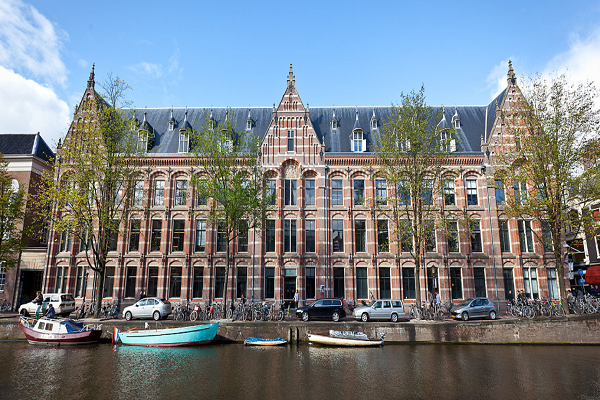University of Amsterdam: Construction transport for new University Library now by water
A sustainable and innovative form of transport is being introduced for the last construction phase of the new University Library (UB) in the University Quarter. From today until the end of the project in 2023, almost all the building materials will be transported by water. This is a major innovation in construction transport for both the University of Amsterdam (UvA) and the City of Amsterdam, because a large-scale building project not located directly by a quayside is now being supplied by way of water.
Innovative and sustainable
A transhipment point has been set up on Grimburgwal for loading and unloading the floating platform, powered by green electricity, that travels between Neptunushaven and Grimburgwal. Small electric trolleys are then used to move the materials from Grimburgwal to their destination at the new UB at the Binnengasthuisterrein (ca. 100 metres away). This means that the entire transport process is powered sustainably by 100% green electricity, while handling 95% of the logistical construction transport. Since the construction no longer suffers delays due to traffic congestion in the Amsterdam city centre, this waterborne transport is now also more efficient. The Chair of the UvA Executive Board, Geert ten Dam, is proud that this allows the UvA to contribute to sustainable and innovative transport: ‘Together with other parties such as the City of Amsterdam, BINX and Zoev City, we’re benefiting the city and promoting sustainability.’
Building contractor BINX Smartility, responsible for the final construction phase of the UB, is realising this waterborne transport together with Zoev City, which is supplying the project with electric barges. Nicole Groothuis, team leader at BINX: ‘We can transport an average of 60 tonnes on every trip with the Zoev barge, that’s equal to two full lorries.’
Collaboration between UvA and City of Amsterdam
A plan has been devised together with the City of Amsterdam to organise delivery of materials through the city to the UB in a way that minimises the burden for specific quays and bridges in a poor state of repair. These quays and bridges, often dating back to medieval times, are no longer suitable for today’s intensive and much heavier traffic. This collaboration has led to a ‘sustainable waterborne transport’ pilot project. Alex ter Haar, project leader New University Library at the UvA, is enthusiastic about this new transportation approach: ‘The inner city is becoming inaccessible for road freight transport, but you simply can’t do without heavy transport for a big building project like this. So waterborne transport presents a sustainable solution to the problem.’
This is a pioneering innovation for both the UvA and the city authorities. Ruben Vrijhoef, project leader Waterborne Transport, City of Amsterdam: ‘This project is truly unique, and also a model for other projects in the city, including the UvA’s follow-up projects around the Binnengasthuisterrein.’

